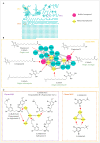New Metabolites from the Marine Sponge Scopalina hapalia Collected in Mayotte Lagoon
- PMID: 35323485
- PMCID: PMC8951328
- DOI: 10.3390/md20030186
New Metabolites from the Marine Sponge Scopalina hapalia Collected in Mayotte Lagoon
Abstract
The biological screening of 44 marine sponge extracts for the research of bioactive molecules, with potential application in the treatment of age-related diseases (cancer and Alzheimer's disease) and skin aging, resulted in the selection of Scopalina hapalia extract for chemical study. As no reports of secondary metabolites of S. hapalia were found in the literature, we undertook this research to further extend current knowledge of Scopalina chemistry. The investigation of this species led to the discovery of four new compounds: two butenolides sinularone J (1) and sinularone K (2), one phospholipid 1-O-octadecyl-2-pentanoyl-sn-glycero-3-phosphocholine (3) and one lysophospholipid 1-O-(3-methoxy-tetradecanoyl)-sn-glycero-3-phosphocholine (4) alongside with known lysophospholipids (5 and 6), alkylglycerols (7-10), epidioxysterols (11 and 12) and diketopiperazines (13 and 14). The structure elucidation of the new metabolites (1-4) was determined by detailed spectroscopic analysis, including 1D and 2D NMR as well as mass spectrometry. Molecular networking was also explored to complement classical investigation and unravel the chemical classes within this species. GNPS analysis provided further information on potential metabolites with additional bioactive natural compounds predicted.
Keywords: Scopalina hapalia; bromotyrosine; butenolides; diketopiperazines; lipids; molecular networking.
Conflict of interest statement
The authors declare no conflict of interest.
Figures






References
-
- Pettit G.R., Tan R., Gao F., Williams M.D., Doubek D.L., Boyd M.R., Schmidt J.M., Chapuis J.C., Hamel E. Isolation and Structure of Halistatin 1 from the Eastern Indian Ocean Marine Sponge Phakellia carteri. J. Org. Chem. 1993;58:2538–2543. doi: 10.1021/jo00061a030. - DOI
-
- Samy M.N., Le Goff G., Lopes P., Georgousaki K., Gumeni S., Almeida C., González I., Genilloud O., Trougakos I., Fokialakis N., et al. Osmanicin, a Polyketide Alkaloid Isolated from Streptomyces osmaniensis CA-244599 Inhibits Elastase in Human Fibroblasts. Molecules. 2019;24:2239. doi: 10.3390/molecules24122239. - DOI - PMC - PubMed
-
- Campos P.-E., Herbette G., Chendo C., Clerc P., Tintillier F., de Voogd N.J., Papanagnou E.-D., Trougakos I.P., Jerabek M., Bignon J., et al. Osirisynes G-I, New Long-Chain Highly Oxygenated Polyacetylenes from the Mayotte Marine Sponge Haliclona sp. Mar. Drugs. 2020;18:350. doi: 10.3390/md18070350. - DOI - PMC - PubMed
MeSH terms
Substances
Grants and funding
LinkOut - more resources
Full Text Sources
Research Materials

